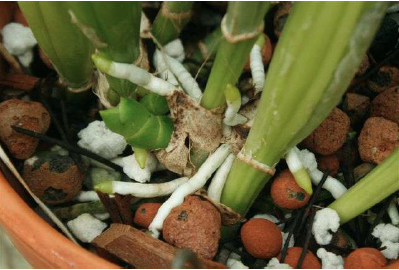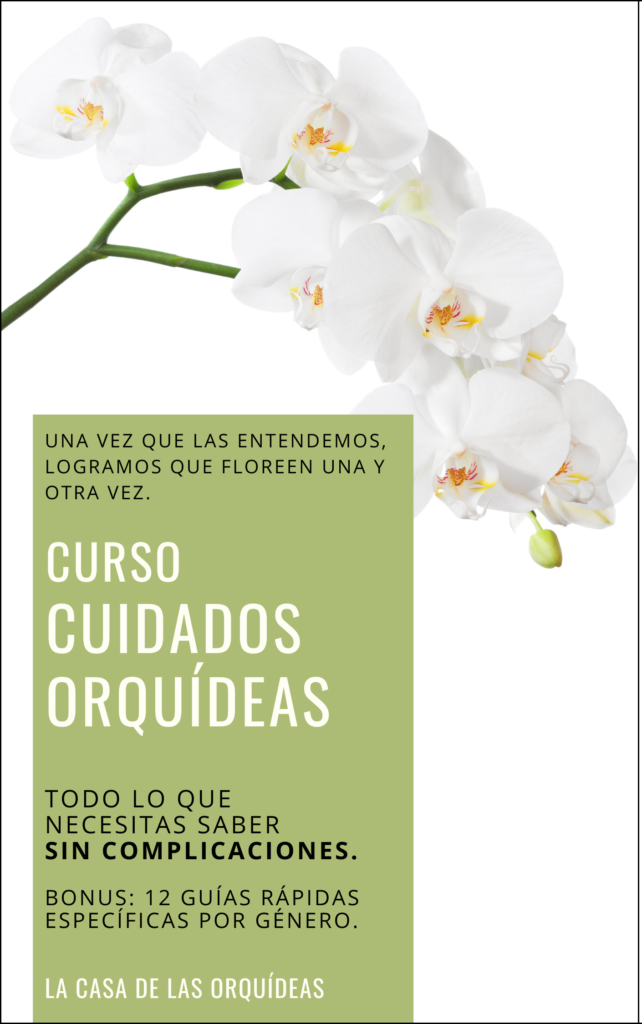+ Spanish

St. Augustine Orchid Society (www.staugorchidsociety.org)
by Sue Bottom, sbottom15@bellsouth.net
If there is only one thing that you need to know to successfully grow orchids, it is that orchid roots are different from the roots on your other houseplants. The orchid root consists of an inside core (cortex) that is very tough and carries nourishment and an outside covering (velamen) that is a spongelike material that absorbs water, fertilizer and oxygen. Healthy root tips are bright green. The longer the green portion, the faster the root is growing.
root function:
Many orchids are epiphytes, meaning they grow on trees, where the roots attach the plant securely, search out nutrition, absorb dew and rainfall among other things.
- Absorb Water. When dry, orchid roots are white but they should quickly turn green when they are watered. When wet, the velamen acts like a sponge, swelling up with water to be absorbed later by the plant. When dry, it acts as an impermeable barrier to prevent water loss from the plant.
- Attach to Substrate. While aerial roots can also take up water and nutrients, their primary purpose is to keep the orchid attached to its surface. Aerial roots, once attached, may become flattened to provide more attachment surface area. The roots cling to any substrate so well that at times it can be very difficult to remove these clinging roots from whatever they are attached to. There is more velamen on aerial roots and they are adapted to the cyclical drenching and drying of intermittent rainstorms. These roots will become soft and green when they have been continually wet for 10 minutes or so, only then will they absorb water.
- Gas Exchange. One very important function of epiphytic roots is the exchange of gases, mostly to take in oxygen and expel carbon dioxide, so they enjoy being exposed to moving fresh air. Most orchids can’t be grown in potting soil. Special high porosity potting mixes have been developed to ensure there is sufficient air around the roots.
- Photosynthesis. Another job for some roots is to photosynthesize, which is why you often see orchids grown in clear pots. There are some orchid species that do not have leaves, but obtain their energy from chlorophyll in their roots.
- Temporary Storage. Many roots also provide temporary storage for food and water.
repotting:
New orchid growers are often terrified of the prospect of dividing and repotting orchids. Without some friendly assistance, new growers will often leave plants in the same potting mix long after that mix has degraded so the plants lose their roots and struggle to survive. Potting orchids in a good mix at the proper time will help ensure their survival and your self confidence in growing orchids.
The best time to repot your orchid is when new roots are just emerging because the plant will become acclimated the most quickly at this time. If you’re careful, you can repot when new roots are a quarter or half inch long. They can be easily broken during the repotting process and when damaged, they will not regrow so if they’re longer than one half inch, wait until they’re 4“ long or more before repotting. It these longer roots are broken during repotting, they’ll branch and continue to grow.
Root growth for some orchid species is almost impossible to initiate except at very specific times in the growth cycle. Some bifoliate cattleya species only put out a very small number of roots in a given year and if these are damaged or destroyed, there will be no growth until the following year at the same time. Bifoliate cattleyas should only be repotted when new roots emerge from the new growth.
Orchid roots become accustomed to their growing environment. When there is a substantial change in this environment, the plant has to grow a different set of roots acclimated to the new conditions.
- When you have a plant that has its aerial roots hanging outside the pot, the roots do not respond well to being placed inside the pot and covering them with growing mix. Better to place them in a bulb pot with a few large chunks of lava rock and after the roots begin to branch, add additional potting mix a little bit at a time.
- The roots of an orchid that has been mounted or grown in a coarse medium tend to be hard and resistant to drying, unlike the fat soft roots found in a sphagnum moss, peat or other water retentive mixtures. Roots on plants grown in sphagnum will not easily adapt to epiphyte-like conditions, nor will roots grown in a coarse, dry medium adapt to sphagnum moss. Roots of both will die if there is a radical change in the type of medium, although new roots will grow and establish in any medium.
- A substantial change in water quality may require the plant to grow new roots to adjust to their new conditions.
encourage root growth:
You can encourage new root growth with some of the root stimulators like rooting hormones, seaweed and SuperThrive, particularly in seedlings or recently repotted plants.
- Rooting hormones are commercially available and usually contain synthetic phytohormones such as synthetic cytokinins and synthetic auxins (naphthalene acetic acid, indole 3 butyric acid and indole acetic acid) that are used to stimulate root growth.
- Seaweed extract is an organic product derived from harvested brown seaweed that contains major and minor nutrients, amino acids and growth promoting substances like auxins, cytokinins and gibberellins (advanced growers may be interested in KelPak). Seaweed extract is often used to start the growth cycle in spring, enhance root growth on seedlings and divisions, and initiate multiple new growths from back bulbs. Using seaweed immediately after repotting is a good practice to encourage new root growth.
- SuperThrive contains the synthetic rooting hormone 1-naphthyl acetic acid at 0.04%, vitamin B1 (thiamine, also known to stimulate root growth) at 0.09%, plus a variety of trade-secret ingredients likely including kelp extracts, humates, soluble iron compounds, and the like. Many growers soak newly deflasked plantlets in a SuperThrive solution or use SuperThrive when repotting to help stimulate root growth.
If you want to have beautiful blooms, you have to have a healthy plant. In order to have a healthy plant, you must have vibrant roots. An orchid without healthy roots cannot grow well and cannot generate enough energy to provide you with the floral reward that will justify all your orchid labors.
check out our store!!
(click on the image)


